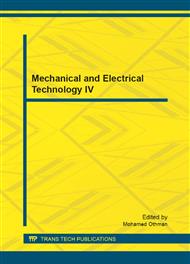p.18
p.22
p.26
p.31
p.35
p.40
p.44
p.51
p.55
Friction and Wear Behavior of Textured Al2O3/TiC Ceramic Surface Filled with MoS2 Solid Lubricants
Abstract:
Three different textures were produced by Laser Surface Texturing (LST) on Al2O3/TiC ceramic surfaces. MoS2 solid lubricants were filled into the textures. The friction and wear properties of textured and untextured surfaces were investigated by carrying out sliding tests against AISI440C stainless steel balls. Results showed that the textured surfaces filled with MoS2 solid lubricants exhibited lower friction coefficient and excellent anti-wear properties compared with untextured surfaces. At the texture spacing of 100μm, 150μm and 200μm, wavy textured surface had the lowest friction coefficient, while it was the dimpled surface at the texture spacing of 250μm. MoS2 film in the spaces between the textures was formed by mechanical engagement of particles in the rough surfaces and solid lubricants in textures. The friction coefficient and wear rates were reduced by supply of solid lubricants from the textures to the surfaces, bulges around the textures and TiO2 formed after laser texturing.
Info:
Periodical:
Pages:
35-39
Citation:
Online since:
November 2012
Authors:
Keywords:
Price:
Сopyright:
© 2012 Trans Tech Publications Ltd. All Rights Reserved
Share:
Citation:


